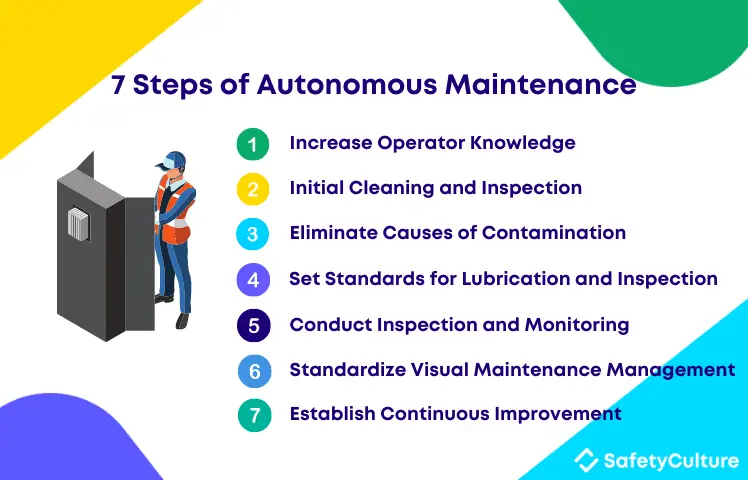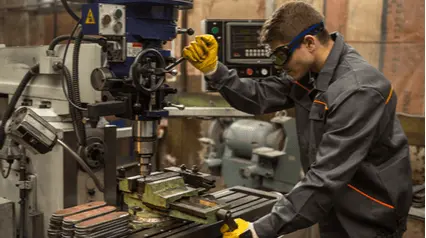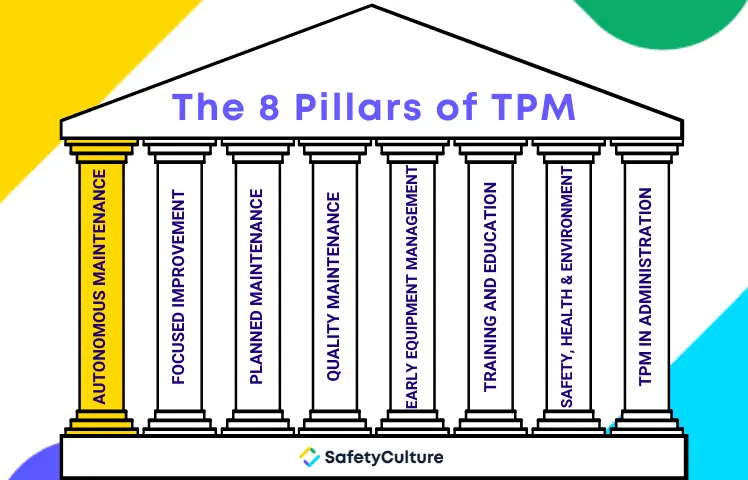What is Autonomous Maintenance?
Autonomous maintenance (AM) is the concept of giving machine operators the responsibility of maintaining the equipment and machinery that they operate instead of relying on maintenance technicians to fulfill routine preventive maintenance tasks.
A preventive maintenance strategy and one of the 8 pillars of Total Productive Maintenance (TPM), autonomous maintenance empowers machine operators with the right training so they can independently identify quality issues and be able to take immediate action to correct them.
What are the Benefits of Performing Autonomous Maintenance?
As a recognized strategy for preventive and proactive maintenance in TPM, autonomous maintenance helps eliminate costly equipment breakdowns and prevent interruptions to operations due to unexpected downtimes or scheduled maintenance. Here is a breakdown of how performing autonomous maintenance can benefit any industry.
Prevents Equipment Deterioration
Autonomous maintenance ensures that routine preventive maintenance tasks such as cleaning, lubricating, and oiling are consistently performed on equipment that need them. These simple but crucial tasks help prolong the optimal performance of equipment and company assets.
Autonomous maintenance also helps dedicated maintenance personnel to focus their full attention on other equipment and more pressing maintenance issues in the workplace.
Instills a Sense of Ownership and Responsibility
The operator who uses the machine or equipment day in and day out would have an intimate knowledge of how the machine actually works and if it is not working at its best. That same operator would then likely know what could be the cause of equipment issues and what should be done consistently to maintain the equipment working “like new.”
Promotes a Culture of Quality and Safety
As equipment and other assets operate at their best, due to the diligence of operators in maintaining them, the cumulative quality of output will be as expected and the overall safety of operating those machines and working around them in the workplace is maintained.
The Seven Steps of Autonomous Maintenance
In order to reap the benefits of performing autonomous maintenance, you should know what are the 7 steps of autonomous maintenance.

Seven Steps of Autonomous Maintenance
Step 1: Increase Operator Knowledge
The first step in effectively implementing autonomous maintenance is to empower operators with the knowledge on how to operate and maintain the equipment that they’re assigned to use. Equip them with knowledge on how the parts of the equipment come together so that they know which parts need periodic maintenance and which parts need to be looked after when it comes to cleaning, lubrication, etc.
Training tools that can increase their knowledge and help them understand practical information the fastest and most effective way possible.
Step 2: Initial Cleaning and Inspection
Once operators know the ins and outs of the equipment they are using, they should be able to inspect the equipment and spot any need for cleaning and maintenance. They need to be able to identify any part of the equipment that needs removal of dust and dirt, nuts and bolts that need tightening, oiling and lubrication, and wear and tear that needs fixing.
Step 3: Eliminate Causes of Contamination
Once the equipment is cleaned and back to its optimal working condition, the operator needs to know how to keep it that way. One way to keep the equipment in top condition is to eliminate causes of contamination. Maintaining good housekeeping and maintaining cleanliness at the workstation helps prevent contamination and keep the working environment safe.
Depending on the type of equipment, cleaning equipment to eliminate contamination may require the use of machine guarding as well as following lockout/tagout (LOTO) procedures to keep workers safe when carrying out cleaning.
Step 4: Set Standards for Lubrication and Inspection
Equipment should be cleaned, lubricated, and maintained according to manufacturer’s specifications in order to maintain its “like new” quality and level of performance. To set standards and reinforce those standards, tools and processes should be implemented on what maintenance tasks to do, how to do them, and how often they should be done.
Use checklist tools that can help guide operators on what to perform, how to perform those maintenance tasks, as well as notify them to remind them when a task is due.
Step 5: Conduct Inspection and Monitoring
To reinforce good practices like autonomous maintenance, it is recommended to conduct inspection and monitoring. Operators themselves can inspect their equipment and provide information in the form of inspection reports with photos on the current condition of the equipment and maintenance tasks fulfilled.
Data collected through these inspections can be monitored to ensure that all equipment are maintained by operators and in good working condition.
Step 6: Standardize Visual Maintenance Management
Make it easier for operators to complete maintenance tasks by implementing the use of visual cues such as color-coded tags and easy-to-understand signs or posters that remind operators and other workers of steps to follow when working with or being around equipment.
Create visual aids of the standards from step 4 to help operators follow and reinforce standards for maintaining equipment and machines.
Step 7: Establish Continuous Improvement
One of the pillars of TPM is improvement and as processes and equipment change, as well as the operators that handle equipment, there is good reason to establish continuous improvement for autonomous maintenance.
Any training feedback gathered from operators in step 1, as well as inspection and monitoring data collected through their reports in step 5 can be used to continuously improve procedures for equipment maintenance.
Achieve operational excellence
Cultivate a culture of excellence with our digital solutions that enhance efficiency, agility, and continuous improvement across all operations.
Explore nowWhat is the Difference Between 5S and Autonomous Maintenance?
5S is a housekeeping practice first applied in manufacturing that stands for Seiri (Sort), Seiton (Systematize), Seiso (Shining), Seiketsu (Standardizing), and Shitsuke (Sustaining). While 5S is the foundation of TPM under which autonomous maintenance belongs, the bottom line of 5S is to eliminate waste, improve flow, and reduce the number of processes where possible. The goal of autonomous maintenance is ultimately to prevent the deterioration of equipment and to keep its “like new” performance through proper management and maintenance.
How to Improve OEE
OEE or Overall Equipment Effectiveness is a manufacturing best practice that enables businesses to calculate how much of an equipment’s potential is being used in accordance with the calculated percentage. This method helps identify strengths, weaknesses, and areas for improvement in maintaining and maximizing equipment to its full potential. The metric used in calculating OEE is based on the factors of availability, performance, and quality. Here are several points on how to improve OEE:
- Calculate effectiveness accurately – Follow guidelines and implement calculation strategies on how to best compute the OEE score. Note that an OEE score of 40% is generally considered low, 60% as the average score, while an 85% score is considered high or world-class.
- Collect and report production data – Streamline data collection by digitizing the methods performed in gathering OEE information. Automating data collection and utilizing new technologies provides more accurate details for OEE reports, allows businesses to gain a timely overview of each equipment or situation, and helps them avoid errors caused by manual processes.
- Implement regular assessments – Relevant people should consistently strategize, collaborate, and discuss best practices to apply in improving OEE. This aids in making sure that everyone is on the same page and hastens the response time needed to address an equipment issue.
- Minimize Six Big Losses – If businesses cannot completely eliminate the reasons for the Six Big Losses, they should at least find ways to minimize their negative impact. The six big losses are composed of unplanned downtime, planned downtime, small stops, slow cycles, production rejects, and start-up rejects.
- Perform Root Cause Analysis – Use the root cause analysis (RCA) to get to the bottom of the encountered issues and understand them in an in-depth manner. Performing RCA also gives the opportunity to identify which solutions to recommend and which preventive measures to implement.
Create your own Root Cause Analysis template
Build from scratch or choose from our collection of free, ready-to-download, and customizable templates.
Browse Root Cause Analysis templatesHow Can SafetyCulture Help in Performing Autonomous Maintenance?
One of the key steps of autonomous maintenance is inspection and monitoring. SafetyCulture (formerly iAuditor) is a powerful mobile platform used in manufacturing and other industries for inspections and monitoring. Using mobile devices to capture information, data can be used to monitor if autonomous maintenance is being done and if the equipment is still in good working condition.
SafetyCulture is most powerful when used in teams and can help standardize maintenance processes, reinforce best practices, and promote continuous improvement for a more effective autonomous maintenance.




